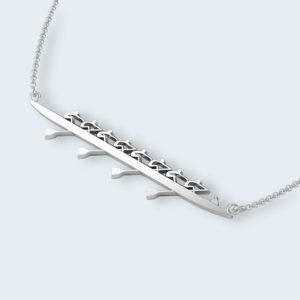Advertisements
A reader wrote to us with a question
“The School Head of Rowing wants me to ‘weight train’ my U15 girls over the winter, all theories about this are discouraged due to their young age and I use circuits with thp using their own body weight, do you have an opinion on this?”
It depends on a couple of things
- how physically mature your 15 year old girls are. If they are nearly finished growing, then it’s considered OK to start with heavier lifting
- weight training takes many forms. I think of it as resistance or load-bearing exercise. Rowing a boat is load bearing exercise. They are pushing their bodies against the mass of water locked into the front of each oar. So weight training is not bad per se.
- I think teaching good weight lifting technique is VERY useful skill. If you can get a skilled trainer in to start to teach your girls how to do the core weight lifts – power cleans, dead lifts and bench press / leg press then this is just fine. Because the technique is complex they cannot carry heavy weights while they are learning.
- you can do weight training on the water using power strokes. These are low rate firm pressure rowing with an additional resistance on the boat. We use a bungee or a boat tie underneath the boat. The drag adds considerably to the load the rowers are moving. If you do two crews side by side they can ‘race’ while doing weights. This will help both competition and the load of resistance you are training in thp.
- Lastly, I’d suggest talking face to face with your Director of Rowing to address your concerns. Come to the talk with an open mind. Ask thp to show you sample circuits they’ve used. Ask about how weight lifting technique can be taught (especially if you are not a trained weight lifting coach) and then, lastly, raise your concerns about their young age. Ask thp for guidance about what to look for if your athletes risk injury. How frequently you can increase the weights and how to check that their muscles are getting the right workout and not getting damaged. If the Director can’t answer these questions, you could suggest that the two of you together go to meet a professional weight lifting instructor and get more information before deciding on the training programme.
Perhaps a solution will be to combine learning weight lifting skill with your body weight circuits so the girls get to lift some weight; or you increase the load in body weights using 0.5 kg bean bags on their legs to make it harder.
Advertisements









This Post Has 7 Comments
I agree with Rebecca, it depends on their maturity, although the majority of research suggests that adolescents should steer away from weight training. The problem you may have is that you will have range of athletes maturing at different rates, so some will cope with the weight training and some will not cope as well.
I would think carefully about how you could answer the requirement in a different manner; a simple answer would be to create a series of on and off the water resistance training exercises that means that you do not have to conduct weight training in the classic sense. So on the water conduct power strokes training as Rebecca has suggested, on the ergo you can do the same by increasing the resistance. Ultimately you want them to produce maximal sustained power per stroke and that is a combination of strength (the ability to exert force (Baechle et al, 2000)) and speed (the ability to move quickly), do not forget the speed bit!
I think body weight circuits are great for rowing training and you may want to investigate using power bags rather weights, they are a bit more forgiving, but you need to still use the right technique. It maybe a good intro to weight training. Teach the proper lifting techniques early, that will limit the risk of injury. A final thought, you know your squad and their capabilities, think of novel ways you can still achieve the same outcomes without resorting to a classic lifting program (over which you have some concerns) and then speak with the Director and unpick what his vision of this program is:
What is his view of their physical capabilities?
Is this program part of the overall physical development structure of the school rowing club?
What are the goals for the program? There is no point just doing weights without having a some element of progression in it (this means you need to baseline your athletes and then monitor them throughout – this takes time)
Does he have a sample program that he thinks you should be following? If so, what does it look like?
What time, type and intensity does it offer than cannot be gained from other novel methods of resistance trg?
Hopefully with an open minded discussion you can come to an agreement that allows you to increase the strength of the athletes and answer you concerns over weight trg and teenagers. Good luck
Regards
Murray
Where is the research that suggests adolescents should not lift weights please? I would like to read it.
Hi Tony,
No such research exists from a reputable and research-driven organization.
Nearly all of the injuries or problematic effects of youth/adolescent strength training are a result of a coaching failure. This includes, but is not limited to, failure to adequately instruct the trainee on the exercises, failure to adequately coach the trainee as she progresses, failure to adequately supervise trainees if training in a group setting, and failure to adequately understand demands of sport and proper fundamentals of strength training.
The good news is there are some great resources out there to help you.
The USA National Strength and Conditioning Association published its “guide to long-term athletic development” which contains some great advice and is research-driven.
Position statement: https://www.nsca.com/long-term_athletic_development_position_statement/
Practical application: https://www.nsca.com/education/articles/practical-application-for-long-term-athletic-development/
The International Youth Conditioning Association also has some helpful information:
http://iyca.org/youth-strength-training-mistakes/
http://iyca.org/how-to-create-a-strength-training-program-for-young-athletes/
Finally, I have written an article on my own experiences training youths in the weight-room. It includes links to research and a clear action plan for you as a coach. I have coached athletes as young as six in the weight-room. As long as you are educated on age-and-sport-appropriate strength training and your trainee is mature enough to follow direction, strength training can be hugely beneficial to your athletes in many, many ways. Just like in rowing, poor coaching in the weight-room can lead to injury, and excellent coaching can lead to excellent performance in both the short-and-long-term.
http://strengthcoachwill.com/2015/08/02/youth-sports-training/
Please feel free to comment here or contact me directly with any questions you have about strength training.
Thanks Will. This belief seems to persist though despite the evidence of a few hundred years of farm kids lifting heavy things and growing up big and strong.
People will always cling to beliefs. Those who want to be successful will look at evidence with an open mind and find the right answer.
I coached teenagers of both gender for decades, and always had them doing resistance training. I did not have any injuries. Perhaps this was because I made sure that they had good technique in performing the exercises and made sure that they did routines that included the complementary exercises to the main rowing orientated lifts. “For every pull there must be a push”.
Good technique needs to hold for more than a few repetitions. The trainees, whatever their age, must repeat the lifts correctly scores of times! Only then should trainees start to increase the load, little by little, maintaining technique.
I agree with Will: no reputable source that I have read says that adolescents should not lift weights!
I agree with the last paragraph of the answer. Some resistance can be added to ordinary circuits and then time can be given separately after the circuit to learning the lifting technique.
Whatever training is done, the coach must explain the relevance of the exercises to the rowing stroke and also to balancing the load around vulnerable joints such as the shoulders and knees!
Most importantly though, for growing adolescents, core abdominal strength needs to come first in their gym training, and static stretching must be emphasised after all training, as the skeleton grows first, with muscles lagging behind.
Robert – these are great observations and thanks for your insight. Totally agree about teaching the technique and ensuring it’s robust and ingrained.